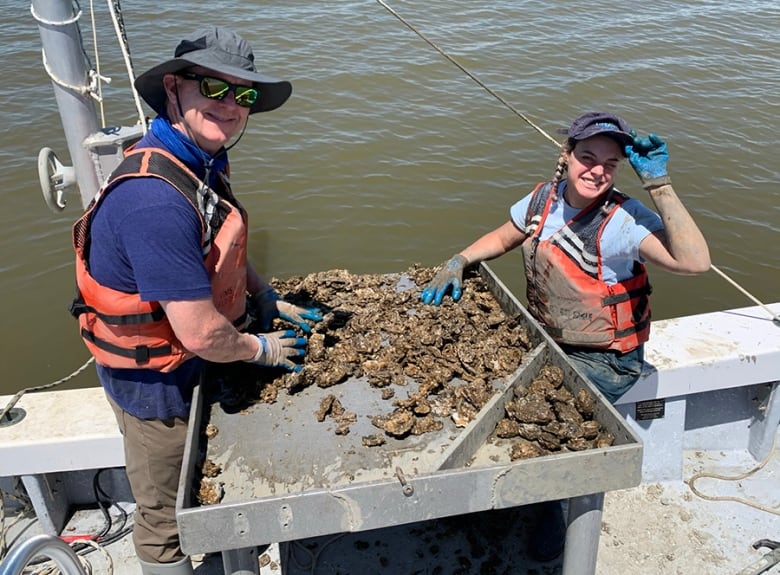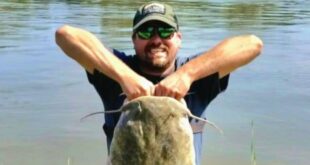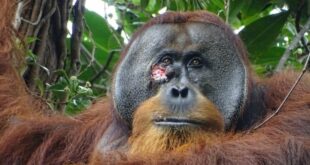Spread of parasite becoming 'more of a concern' as waters warm, Rod Beresford says

A biologist at Cape Breton University is hoping a piece of technology used to keep people safe in the pandemic can help protect Nova Scotia's oysters against the effects of warming waters.
Perkinsus marinus, or "dermo" disease, is a single-cell organism that has contributed to significant oyster declines in the southeastern United States. It has been detected in the northeastern U.S.
Though dermo is not yet found in Canada, researchers say that could change as ocean temperatures around the province reach record highs. This summer, biologist Rod Beresford is adapting a testing technology — the same one that helped detect COVID-19 in wastewater — to monitor for the threat.
"As we see how quickly water temperatures are changing in some of these places, it's quickly starting to become a bit more of a concern," said Beresford.
The monitoring is part of a push from researchers to help the region's oysters — and oyster growers — prepare for the effects of climate change.
"Given dermo's proximity in Maine, that's not a long distance for something to travel, as things move around," he said. "There's all kinds of ways invasive species can be introduced to an area. And as the waters warm, an area that, at one point, may have been too cold, might not be too cold anymore."
'Every bit as destructive'
Beresford's research typically focuses on MSX, an invasive oyster parasite that has wiped out much of the oyster production in the Bras d'Or Lake.
MSX arrived in Cape Breton in 2002, and quickly devastated wild and cultivated oyster populations in the region.
Beresford's came to work with local oyster growers, including Joe Googoo from Waycobah First Nation, and aquaculture expert Robin Stuart. The collaboration helped Beresford realize that the key to recovery could be that in shallow water — where the temperature and salinity are changing constantly — oysters survived despite the presence of the parasite.
"If you're an oyster … they're used to living in these changing environments. But if you're a parasite, especially a single cell parasite, that's a bit of a challenge."
That led to the development of a system of floating cages, which has shown promising results for restoring oyster production to the area.
"We're fairly confident now that you can grow oysters in the Bras d'Or in the presence of this parasite, which is harmless to humans."
Wanting to focus more on the threats posed by climate change, Beresford has now turned to other diseases, and to the threat posed by dermo, which he says is "every bit as bit as destructive as MSX, if not more."

Dermo attacks the tissues of oysters. Once ingested, it can proliferate in the blood cells, eventually killing the animal.
Because the disease is transmitted between oysters, Beresford says a tool that makes it easier to detect can help oysters growers respond, and potentially limit the spread. That led Beresford to look at a rapid test made by Atlantic Canadian company LuminUltra, which had been developed to monitor COVID-19 in wastewater.
"A rapid test is critical because you can take it right to the farm. You're not waiting for days to get results," he says. "The sooner you have that information, the sooner you can do something about it."
Beresford's lab has been adapting the DNA test to the protozoan, which is different from a virus, using positive dermo samples from Virginia in the United States. He will be conducting further tests with oyster producers in the Yarmouth area this summer.
Research suggest dermo evolves
Research on dermo in Virginia suggests monitoring is important, as dermo can behave in surprising ways.
Ryan Carnegie, a professor at the Virginia Institute of Marine Science, says dermo is associated with southern waters, including the Gulf of Mexico, where it was once a chronic disease.
"It's most active where temperatures are above 20 degrees Celsius, or especially above 20 to 25 degrees Celsius, for some length of time," says Carnegie.

But in the 1980s, dermo began to spread northward toward Maine; at the same time, it became more aggressive, killing oysters in a short period of time. For decades, Carnegie says this sudden increase in severity was attributed to a multi-year drought, which was thought to have caused an outbreak of disease that is still cycling through oyster populations.
But when Carnegie examined samples of the parasite from the 1960s, versus those from the present day, he realized the species had evolved.
"It looks different. It's infecting a different part of the body of the animal. It's just doing different things," he says.

Carnegie published the result of that investigation in a 2021 research paper, which hypothesized that the shift in the epidemiology of dermo was a result of the arrival of MSX on the eastern seaboard. MSX causes oysters to die quickly, which potentially forced dermo itself to become more virulent to compete, killing oysters in months rather than years.
Carnegie says that evolution shows it's important to consider how the disease could adapt as it makes its way northward.
"We can't necessarily predict where evolution is going to take Perkinsus marinus. Even if we don't think it's capable of thriving in cooler environments, that's not to say that [dermo] is not going to change," he says. "Really the bottom line lesson behind this 2021 paper is that we need to be constantly attuned to what these major pathogens are up to."
Selective breeding builds climate resilience
Some researchers are investigating how selective breeding can also help producers manage disease risk, going forward.
Martin Mallet owns Mallet oysters, in northern New Brunswick, with his brother and father.
After completing his PhD in evolutionary biology, Mallet became interested in oysters, and specifically the way selective breeding could meet two challenges: the need for baby oysters in a growing Atlantic Canadian industry, and the need for more resilient oysters.
That led to a breeding program for eastern oysters. In its first phase, Mallet's research involves sequencing wild oyster genomes and breeding oyster seed. This year, that seed is available to oyster producers for the first time.
So far, the breeding program is focused on producing oysters that work well in aquaculture settings. But Mallet says they could ultimately help producers fend off disease.
He described disease as the greatest risk climate change poses to eastern oysters, since research suggests they have some resistance to ocean acidification and can withstand higher water temperatures.
"What we do have is diseases that exist further south that are not found in our waters yet, that can move north with changing climate."
As an example of how breeding can help, Mallet points to the impact of Malpeque disease on New Brunswick oysters in the 1960s. Ninety-five percent of oysters died, and Fisheries and Oceans Canada had to re-introduce thousands of tonnes of oysters to breed disease resistance and recover the population, which took decades.
"If a similar type of disease, or a new type of disease, hits our oyster beds, we don't really want to wait 30 years," he says. "So having the breeding structure in place already will help us identify, hopefully, families that have resistance and begin the recovery process much faster."
In the Bras d'Or Lake, Beresford's lab is also at the point of starting a hatchery, with plans to start producing mature oysters for breeding this summer.
Going forward, Beresford says these measures can help oysters provide the basis of a relatively climate-change resilient industry and food source.
As for the dermo monitoring, he says it could ultimately help growers prepare for the threats that do exist.
"There's so many things we don't know. But the more we work on the things that we do know, it positions us better so that when unknowns do land on our shores, we have that many more skills and abilities to apply to it, to figure out ways to limit its impact."
*****
Credit belongs to : www.cbc.ca
 MaharlikaNews | Canada Leading Online Filipino Newspaper Portal The No. 1 most engaged information website for Filipino – Canadian in Canada. MaharlikaNews.com received almost a quarter a million visitors in 2020.
MaharlikaNews | Canada Leading Online Filipino Newspaper Portal The No. 1 most engaged information website for Filipino – Canadian in Canada. MaharlikaNews.com received almost a quarter a million visitors in 2020.







